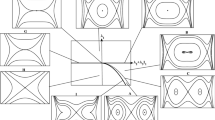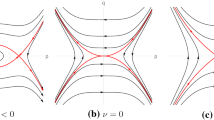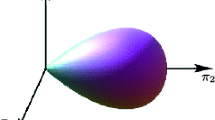Abstract
We deal with Hamiltonian bifurcations associated with the reversible umbilic in two degrees of freedom systems defined by 0:1 resonance, i.e. the unperturbed equilibrium has two purely imaginary eigenvalues and a semisimple double-zero one. The Hamiltonian is written as the sum of integrable Hamiltonian \(N\big (\frac{1}{2}(x^{2}+y^{2}),q,p;\lambda \big )\) and a small perturbation \(P(x,y,q,p;\lambda )\) by the normalization procedure. The phase portrait of N on each level of the integral \(I_{1}=\frac{1}{2}(x^{2}+y^{2})\) is then studied in detail, obtaining an unfolding related to the reversible hyperbolic umbilic catastrophe. The persistence of 2-tori (i.e. two-dimensional tori) for the full system is analysed via KAM theory pointed out just as in Broer et al. (Z Angew Math Phys 44: 389–432, 1993), (in: Langford, Nagata (eds) Normal forms and homoclinic chaos, Waterloo, (1992), Fields Institute Communications 4 (1995)). In a sense, our results can be seen as a four-dimensional extension of a planar problem studied by Hanßmann (Phys D 112: 81–94, 1998).



Similar content being viewed by others
Change history
02 August 2021
A Correction to this paper has been published: https://doi.org/10.1007/s11071-021-06744-1
References
Arnold, V.I.: Small denominators and problems of stability of motion in classical mechanics. Usp. Math. Nauk. 18, 91–192 (1963)
Arnold, V.I.: Normal forms of functions near degenerate critical points, the Weyl groups of \(A_{k}, D_{k}, E_{k}\) and Lagrangian singularities. Funct. Anal. Appl. 6, 254–272 (1972)
Arnold, V.I.: Dynamical Systems III. Springer, Berlin (1988)
Arnold, V.I.: Mathematical Methods of Classical Mechanics. Springer, Berlin, New York (1989)
Broer, H.W., Chow, S.-N., Kim, Y., Vegter, G.: A normally elliptic Hamiltonian bifurcation. Z. Angew. Math. Phys. 44, 389–432 (1993)
Broer, H.W., Chow, S.-N., Kim, Y., Vegter, G.: The Hamiltonian double-zero eigenvalue. In: Langford, W.E., Nagata, W. (eds.) Normal Forms and Homoclinic Chaos, Waterloo, (1992), Fields Institute Communications 4 (1995) pp 1–19
Broer, H.W., Lunter, G.A., Vegter, G.: Equivariant singularity theory with distinguished parameters: two case studies of resonant Hamiltonian systems. Phys. D 112, 64–80 (1998)
Broer, H.W., Hoveijn, I., Lunter, G.A., Vegter, G.: Resonances in a spring-pendulum: algorithms for equivariant singularity theory. Nonlinearity 11, 1569–1605 (1998)
Broer, H.W., Hoveijn, I., Lunter, G., Vegter, G.: Bifurcations in Hamiltonian Systems. Lecture Notes in Mathematics, vol. 1806. Springer, New York (2003)
Eldhuset, K.: A new fourth-order processing algorithm for spaceborne SAR. IEEE Trans. Aerospace Electron. Syst. 34, 824–835 (1998)
Fine, H.B.: College Algebra. Dover Publications Inc, New York (1961)
Gelfreich, V., Lerman, L.: Separatrix splitting at a Hamiltonian \(0^2 i\omega \) bifurcation. Regul. Chaotic Dyn. 19, 635–655 (2014)
Goodman, R.H.: Bifurcations of relative periodic orbits in NLS/GP with a triple-well potential. Phys. D 359, 39–59 (2017)
Hanßmann, H.: The reversible umbilic bifurcation. Phys. D 112, 81–94 (1998)
Hanßmann, H.: Local and Semi-local Bifurcations in Hamiltonian Dynamical Systems. Springer, Berlin Heidelberg (2007)
Han, Yuecai, Li, Yong, Yi, Yingfei: Invariant tori in Hamiltonian systems with high order proper degeneracy. Ann. Henri Poincaré 10, 1419–1436 (2010)
Hoveijn, I.: Versal deformations and normal forms for reversible and Hamiltonian linear systems. J. Differ. Equ. 126, 408–442 (1996)
Jezequel, T., Bernard, P., Lombardi, E.: Homoclinic orbits with many loops near a \(0^2 i\omega \) resonant fixed point of Hamiltonian systems. Disc. Contin. Dyn. Syst. 36, 3153–3225 (2016)
Liao, Y., Zhang, S., Xu, G., Xing, M.: A novel imaging algorithm for circular scanning SAR based on the Cardano’s formula. IET International Radar Conference (2013)
Robinson, R.C.: Generic properties of conservative systems I. Am. J. Math. 92, 562–603 (1970)
Robinson, R.C.: Generic properties of conservative systems II. Am. J. Math. 92, 897–906 (1970)
Rüssmann, H.: Invariant tori in non-degenerate nearly integrable Hamiltonian systems. Regul. Chaotic Dyn. 6, 119–204 (2001)
Sang Koon, W., Owhadi, H., Tao, M.: Control of a model of DNA division via parametric resonance. Chaos 23, 013117 (2013)
Sokolskii, A.G.: On stability of an autonomous Hamiltonian system with two degrees of freedom under first-order resonance. J. Appl. Math. Mech. 41, 4–33 (1977)
Tang, Yilei, Zhang, Weinian: Versal unfolding of planar Hamiltonian systems at fully degenerate equilibrium. J. Differ. Equ. 261, 236–272 (2016)
Wassermann, G.: Stability of Unfoldings. Lecture Notes Mathematics 393. Springer, New York (1974)
Wituła, R., Słota, D.: Cardanos formula, square roots, Chebyshev polynomials and radicals. J. Math. Anal. Appl. 363, 639–647 (2010)
Xu, Junxiang, You, Jiangong, Qiu, Qingjiu: Invariant tori for nearly integrable Hamiltonian systems with degeneracy. Math. Z. 226, 375–387 (1997)
Acknowledgements
This work is supported by the NNSF(11971163) of China, by Key Laboratory of High Performance Computing and Stochastic Information Processing.
Author information
Authors and Affiliations
Corresponding author
Additional information
Publisher's Note
Springer Nature remains neutral with regard to jurisdictional claims in published maps and institutional affiliations.
The original online version of this article was revised: ” Various typesetting errors have been amended.
Appendices
A Appendix: Cardano’s formula for solving cubic equation
Here, we will use the Cardano’s formula to calculate the q-coordinate values of the intersection points of the q-axis and the energy curve \(\Gamma \). According to (2.7), when \(p=0\), the expression of the energy curve \(\Gamma \) is changed to
where h denotes the energy value at the point (q, 0). The square member may be removed by the substitution \(q=t+\lambda _{1}\), and (A.1) can be rewritten as the canonical form of the cubic equation
where
the expression \(\Delta :=\frac{1}{4}n^{2}+\frac{1}{27}m^{3}\) is called the discriminant of the cubic equation (A.2).
Using Cardano’s formula[11, 27] for the cubic equation (A.1), we obtain the q-coordinate values of the intersection points of the q-axis and the energy curve \(\Gamma \) shown in Figs. 2 and 3 (note that in Figs. 2 and 3, we only marked some of the q-coordinate values involved in the proof of Theorems 3.5 and 3.11, while ignored other q-coordinate values). In fact, the q-coordinate value \(q_{ij}(h)\) depends on the energy value h. To simplify the notation, we abbreviate \(q_{ij}(h)\) as \(q_{ij}\) in this appendix.
Lemma 4.1
If \(m=n=0(\Leftrightarrow h=h_{\eta _{+}}=h_{\eta _{-}}=\frac{1}{3}\lambda _{1}^{3})\), then the cubic equation (A.1) has one triple root, namely \(q_{1,2,3}=\lambda _{1}\). This situation corresponds to the q-coordinate value of the only parabolic equilibrium point (i.e. subgraph F and subgraph H in Fig. 1) when \(\lambda _{2}+\lambda _{3}I_{1}=\lambda _{1}^{2}\). Otherwise, we have the following three situations:
-
(i) If \(\Delta <0(\Leftrightarrow h\in (h_{\eta _{+}},h_{\eta _{-}}))\), then (A.1) has three distinct real roots, namely \(q_{1i}<q_{2i}<q_{3i}\) (\(i=0\) if \(\lambda \in \Pi ^{A};\) \(i=1,2\) if \(\lambda \in \Pi ^{B}\)) (cf.[10, 19]):
$$\begin{aligned}&\left\{ \begin{array}{ll} q_{1i}=\lambda _{1}+\frac{-1+\sqrt{-1}\sqrt{3}}{2}\root 3 \of {-\frac{n}{2}+\sqrt{\Delta }}+\frac{-1-\sqrt{-1}\sqrt{3}}{2}\root 3 \of {-\frac{n}{2}-\sqrt{\Delta }}=\lambda _{1}+2\sqrt{-\frac{m}{3}}\cos (\frac{\phi }{3}+\frac{2\pi }{3})\\ q_{2i}=\lambda _{1}+\frac{-1-\sqrt{-1}\sqrt{3}}{2}\root 3 \of {-\frac{n}{2}+\sqrt{\Delta }}+\frac{-1+\sqrt{-1}\sqrt{3}}{2}\root 3 \of {-\frac{n}{2}-\sqrt{\Delta }}=\lambda _{1}+2\sqrt{-\frac{m}{3}}\cos (\frac{\phi }{3}-\frac{2\pi }{3})\\ q_{3i}=\lambda _{1}+\root 3 \of {-\frac{n}{2}+\sqrt{\Delta }}+\root 3 \of {-\frac{n}{2}-\sqrt{\Delta }}=\lambda _{1}+2\sqrt{-\frac{m}{3}}\cos \frac{\phi }{3}, \end{array} \right. \end{aligned}$$(A.4)where
$$\begin{aligned} \phi =\arccos \frac{-n\sqrt{-27m}}{2m^{2}} \end{aligned}$$(A.5)depends on the energy value h;
-
(ii) If \(\Delta =0\) and \((m,n)\ne (0,0)(\Leftrightarrow h=h_{\eta _{-}}~\mathrm{or}~h_{\eta _{+}}~(h_{\eta _{+}}\ne h_{\eta _{-}}))\), then (A.1) has three real roots, whereby at least two of them are equal. If \(h=h_{\eta _{-}}\), (A.1) has three real roots \(q_{4,5}<q_{6}:\)
$$\begin{aligned} \left\{ \begin{array}{ll} q_{4,5}=\lambda _{1}+\root 3 \of {\frac{n}{2}}=\lambda _{1}-\sqrt{\lambda _{1}^{2}-(\lambda _{2}+\lambda _{3}I_{1})}:=q_{\eta _{-}}\\ q_{6}=\lambda _{1}-2\root 3 \of {\frac{n}{2}}=\lambda _{1}+2\sqrt{\lambda _{1}^{2}-(\lambda _{2}+\lambda _{3}I_{1})}; \end{array} \right. \end{aligned}$$If \(h=h_{\eta _{+}}\), (A.1) has three real roots \(q_{9}<q_{7,8}\):
$$\begin{aligned} \left\{ \begin{array}{ll} q_{7,8}=\lambda _{1}+\root 3 \of {\frac{n}{2}}=\lambda _{1}+\sqrt{\lambda _{1}^{2}-(\lambda _{2}+\lambda _{3}I_{1})}:=q_{\eta _{+}}\\ q_{9}=\lambda _{1}-2\root 3 \of {\frac{n}{2}}=\lambda _{1}-2\sqrt{\lambda _{1}^{2}-(\lambda _{2}+\lambda _{3}I_{1})}; \end{array} \right. \end{aligned}$$ -
(iii) If \(\Delta >0(\Leftrightarrow h\in (-\infty ,h_{\eta _{+}})\bigcup (h_{\eta _{-}},+\infty ))\), then (A.1) has only one simple real root:
$$\begin{aligned} q=\lambda _{1}+\root 3 \of {-\frac{n}{2}+\sqrt{\Delta }}+\root 3 \of {-\frac{n}{2}-\sqrt{\Delta }}. \end{aligned}$$
Remark 4.2
We are easy to obtain the extreme points of E(q) are \(q_{\eta _{\pm }}=\lambda _{1}\pm \sqrt{\lambda _{1}^{2}-(\lambda _{2}+\lambda _{3}I_{1})}.\) It is easy to show that E(q) is strictly monotonously increasing when \(q<q_{\eta _{-}}\) and \(q>q_{\eta _{+}}\), strictly monotonously decreasing when \(q_{\eta _{-}}<q<q_{\eta _{+}}\), and that \(q_{\eta _{-}}\) and \(q_{\eta _{+}}\) are the maximum and minimum points of E(q), respectively. Therefore, we imply that for the energy value \(h_{\kappa }\) of the point \((q_{\kappa },0)\) on the q-axis,
B Appendix: Some calculations involved in subsection 3.1
1.1 B.1 Formulas of \(\widetilde{q}_{i0}~(i=1,2,3)\) in (3.11)
For \(\lambda \in \Pi ^{A}\), we have
According to Lemma 4.1 in Appendix A, the existence condition of the three q-coordinate values \(q_{i0}~(i=1,2,3)\) in Case A is \(h\in (h_{\eta _{+}},h_{\eta _{-}})\). From (2.5) and (B.1), it follows
Thus, we have
By (A.3) and (B.1), we can rewrite m and n as
Noting (B.2), (B.3) and inserting (B.4) into (A.5) yields
where
Therefore, \(\phi \in (0,\pi )\) and depends on \(\lambda _{A}\) and \(\widetilde{h}\).
From Remark 3.4 and Remark 3.6, in order to prove Theorem 3.5, we need to take
where
Thus,
Noting (B.5)-(B.8), we have \(F_{1}(\lambda _{A},\widetilde{h})\in (F_{1}(\lambda _{A},\widetilde{h}_{1}),F_{1}(\lambda _{A},\widetilde{h}_{2}))=(\frac{\sqrt{2}}{2},\cos \frac{\pi }{8})\subset (-1,1)\). Therefore, we get
and depends on \(\lambda _{A}\) and \(\widetilde{h}\).
Inserting (B.4) into (A.4) yields
where the expression of \(\phi \) is shown in (B.5). By (B.6), (B.9) and (B.10), we have
where we use these facts that \(\cos (\frac{\phi }{3}-\frac{2\pi }{3})\in (-0.3827,-0.2590)\), \(\cos \frac{\phi }{3}\in (0.9660,0.9914)\), \(\sin \frac{\phi }{3}\in (0.1305,0.2586)\) and \(\sin (\frac{\phi }{3}+\frac{\pi }{3})\in (0.9239,0.9659)\).
1.2 B.2 Formulas of a, b and c in (3.17) and their estimates
Noting (B.6), (B.7) and (B.8), by (A.5), (B.4) and (B.10), we can get
where
Noting (B.9), inserting (B.10), (B.12) into (3.17) and simplifying, we have
where \(f_{1}(\phi ):=-6\sin (\frac{2\phi }{3}-\frac{2\pi }{3})\), \(f_{2}(\phi ):=2\sqrt{3}\cos (\frac{\phi }{3}-\frac{\pi }{3})\), \(f_{3}(\phi ):=4\sqrt{3}\cos (\frac{2\phi }{3}-\pi )-2\sqrt{3}\cos (\frac{2\phi }{3}+\frac{\pi }{3})\), \(f_{4}(\phi ):=-2\sqrt{3}\cos \frac{\phi }{3}\) and \(f_{5}(\phi ):=-2\sqrt{3}\cos (\frac{2\phi }{3}-\frac{2\pi }{3})\).
From (B.9), we can get the facts: \(f_{1}(\phi )\in (5.7956,6)\), \(f_{4}(\phi )\in (-3.4345,-3.3463)\), \(f_{5}(\phi )\in (0.0016,0.8966)\), \(f_{2}(\phi )+f_{4}(\phi )\in (-1.3257,-0.8974)\) and \(f_{1}(\phi )+f_{3}(\phi )+f_{5}(\phi )\in (-0.8966,-0.0016)\). Finally, applying (B.6) and (B.13) to (B.14), we have
where
C. Appendix: Some calculations involved in subsection 3.2
1.1 C.1 Formulas of \(\widehat{q}_{i1}~(i=1,2,3)\) in (3.34)
For \(\lambda \in \Pi ^{B}\), we have
According to Lemma 4.1 in Appendix A, the condition on the existence of the three q-coordinate values \(q_{i1}~(i=1,2,3)\) in Case B is \(h\in (h_{\mathrm{het}},h_{\eta _{-}})\subset (h_{\eta _{+}},h_{\eta _{-}})\). By (2.5) and (2.6), it follows
Then we have
By (A.3) and (C.1), we rewrite m and n as
By (C.1)-(C.4), inserting (C.5) into (A.5) yields
where
Thus, \(G_{1}^{1}(\lambda _{B},\widehat{h})\in (G_{1}^{1}(\lambda _{B},\widehat{h}_{\mathrm{het}}^{1}),G_{1}^{1}(\lambda _{B},\widehat{h}_{\eta _{-}}^{1}))\subset (0,1),\) \(G_{1}^{2}(\lambda _{B},\widehat{h})\in (G_{1}^{2}(\lambda _{B},\widehat{h}_{\mathrm{het}}^{2}),G_{1}^{2}(\lambda _{B},\widehat{h}_{\eta _{-}}^{2}))\subset (-1,1).\) Therefore, if \(\lambda _{1}\geqslant 0\), then \(\phi \in (0,\frac{\pi }{2})\) and if \(\lambda _{1}<0\), then \(\phi \in (0,\pi )\).
From Remark 3.10 and Remark 3.12, in order to prove Theorem 3.11, we need to take
where
\(\widehat{h}_{3}^{i}(\in (\widehat{h}_{\mathrm{het}}^{i},\widehat{h}_{4}^{i}),~i=1,2)\) are two functions depending on \(\lambda _{B}\) and satisfy the condition:
Thus,
By (C.6)-(C.10) and \(G_{1}^{i}(\lambda _{B},\widehat{h}_{4}^{i})\equiv \cos \frac{\pi }{100}~(i=1,2)\), we have
Therefore, for all \(\lambda _{1}\in \mathbb {R}^{1}\) and \(\lambda _{B}\in (-\frac{7}{30},0]\), we have
and depends on \(\lambda _{B}\) and \(\widetilde{h}\).
Substituting (C.5) into (A.4) gives that if \(\lambda _{1}\geqslant 0\), then
and if \(\lambda _{1}<0\), then
where the expression of \(\phi \) is given in (C.6). Due to (C.7), (C.11)-(C.13) and facts \(\cos (\frac{\phi }{3}-\frac{2\pi }{3})\in (-0.4909,-0.4834)\), \(\cos (\frac{\phi }{3}+\frac{2\pi }{3})\in (-0.5164,-0.5090)\), \(\sin (\frac{\phi }{3}-\frac{\pi }{3})\in (-0.8607,-0.8563)\) and \(\sin (\frac{\phi }{3}+\frac{\pi }{3})\in (0.8712,0.8754)\), it is easy to obtain that
1.2 C.2 Formulas of \(a_{i},b_{i}\) and \(c_{i}~(i=1,2)\) in (3.40)–(3.42) and their estimates
By (A.3), (A.5), (C.5), differentiating (C.12) (and (C.13)) with respect to h and simplifying the equalities, we obtain
where
Combining (C.2), (C.7) and (C.8), we have
Thus,
Noting (C.11), inserting (C.12) (or (C.13)), (C.15) into (3.40)-(3.42), we have
where \(g_{1}^{1}(\phi )=g_{1}^{2}(\phi ):=-6\sin \frac{2\phi }{3}\in ( -0.2284,-0.1257)\), \(g_{2}^{1}(\phi ):=-2\sqrt{3}\cos \frac{\phi }{3}\in ( -3.4639, -3.4635)\), \(g_{2}^{2}(\phi )=-g_{2}^{1}(\phi )\in ( 3.4635, 3.4639)\), \(g_{3}^{1}(\phi )=g_{3}^{2}(\phi ):=-4\sqrt{3}\cos (\frac{2\phi }{3}-\frac{2\pi }{3})-2\sqrt{3}\cos \frac{2\phi }{3}\in (-0.2284, -0.1257)\), \(g_{4}^{1}(\phi ):=-2\sqrt{3}\cos (\frac{\phi }{3}-\frac{\pi }{3})\in ( -1.7888, -1.7634)\), \(g_{4}^{2}(\phi )=-g_{4}^{1}(\phi )\in (1.7634, 1.7888)\) and \(g_{5}^{1}(\phi )=g_{5}^{2}(\phi ):=-2\sqrt{3}\cos (\frac{2\phi }{3}-\pi )\in (3.4616,3.4633)\).
Applying (C.7) and (C.16) to (C.17), we have
where
D Appendix: A KAM theorem for nearly integrable Hamiltonian systems
Consider the following Hamiltonian systems
with Hamiltonian \(H(q,p)=h(p)+\varepsilon f(q,p)\), \((q,p)\in \mathbb {T}^{n} \times D \), \(n\geqslant 2\), where \(p=(p_{1},p_{2},\ldots ,p_{n})\) are action variables in some bounded connected domain \(D\subset \mathbb {R}^{n}\), and \(q=(q_{1},q_{2},\ldots ,q_{n})\in \mathbb {T}^{n}:=\mathbb {R}^{n}/(2\pi \mathbb {Z})^{n}\) are conjugate angular variables.
Lemma 4.3
[28, Theorem A] Suppose that \(H(q,p)=h(p)+\varepsilon f(q,p)\) is analytic in \(\mathbb {T}^{n}\times \overline{D}\), where \(\overline{D}\) is the closure of D. If for each \(p\in D\)
where \(\omega (p)=\frac{\partial h(p)}{\partial p}\) and \(\frac{\partial ^{\mid k\mid }\omega }{\partial p^{k}}=(\frac{\partial ^{\mid k\mid }\omega _{1}}{\partial p^{k}},\frac{\partial ^{\mid k\mid }\omega _{2}}{\partial p^{k}},\ldots ,\frac{\partial ^{\mid k\mid }\omega _{n}}{\partial p^{k}})\), then for \(\forall \gamma >0\) sufficiently small, there exists \(\varepsilon _{0}=\varepsilon _{0}(\gamma )>0\) such that if \(|\varepsilon |<\varepsilon _{0}\), there exists a nonempty Cantorian-like subset \(D_{\gamma }\subset D\) such that (D.1) admits a family of invariant n-tori \(\{{\mathcal {T}}_{p}^{n} : p\in D_{\gamma }\}\), whose frequencies \(\omega _{*}(p)\) satisfy \(|\omega _{*}(p)-\omega (p)|\leqslant c\varepsilon \) with c being a constant independent of \(\varepsilon \). Moreover, \(\mathrm{Meas}(D\backslash D_{\gamma })=O(\gamma )\), where \(O(\gamma )\rightarrow 0\) as \(\gamma \rightarrow 0\).
Rights and permissions
About this article
Cite this article
Zhou, X., Li, X. Bifurcations in a Hamiltonian system with two degrees of freedom associated with the reversible hyperbolic umbilic. Nonlinear Dyn 105, 2005–2029 (2021). https://doi.org/10.1007/s11071-021-06629-3
Received:
Accepted:
Published:
Issue Date:
DOI: https://doi.org/10.1007/s11071-021-06629-3




